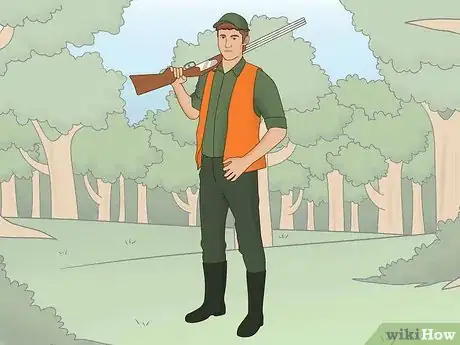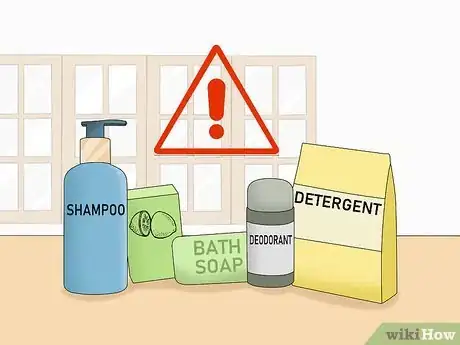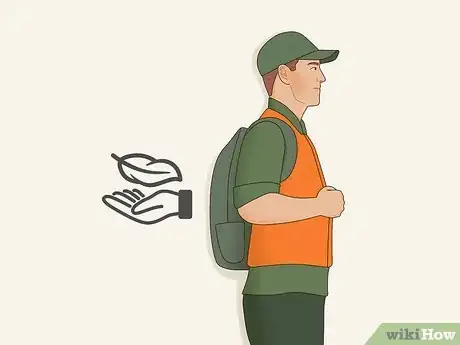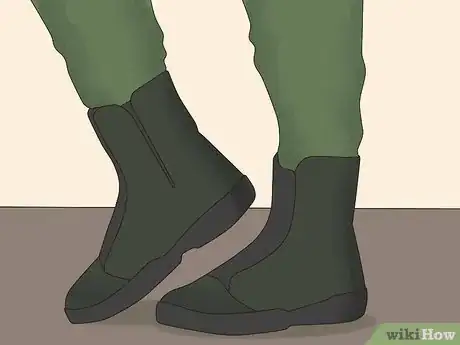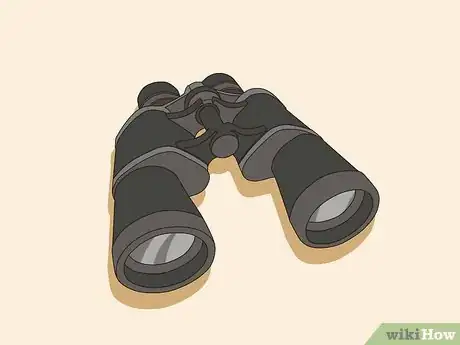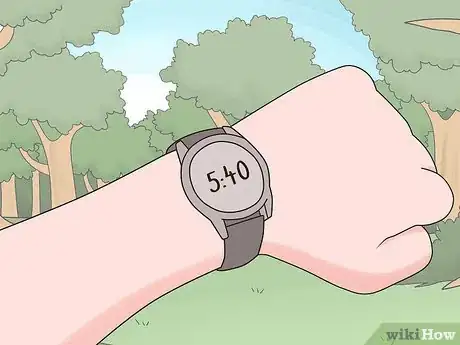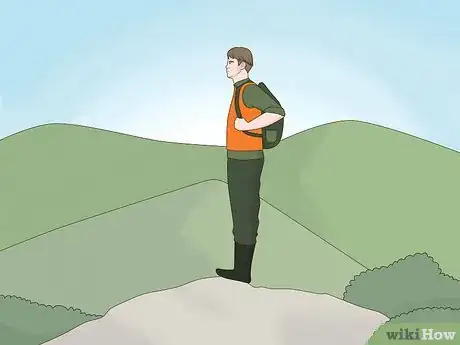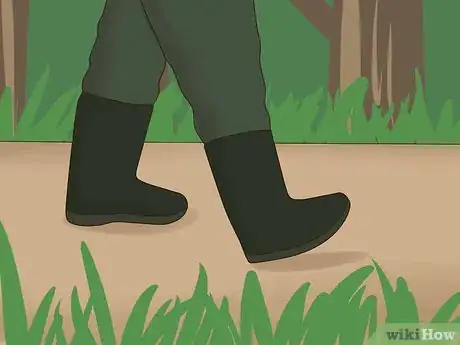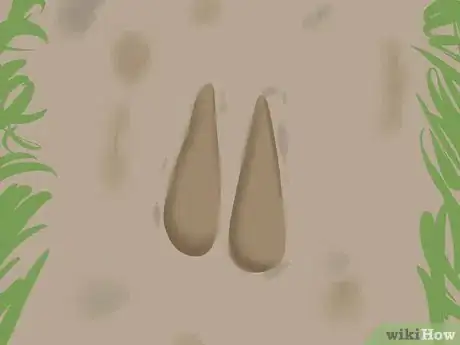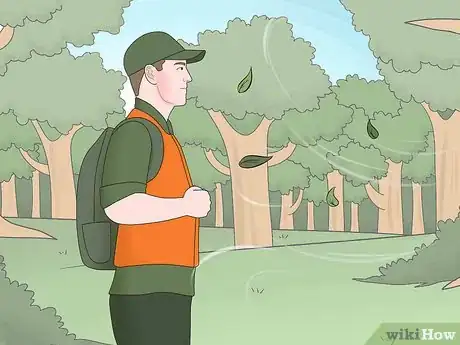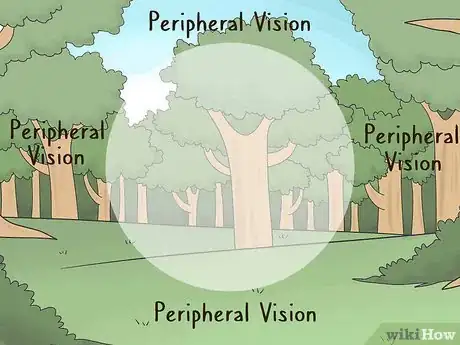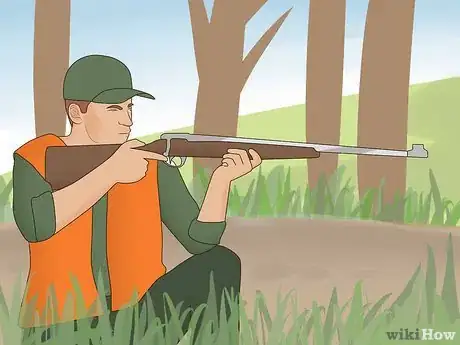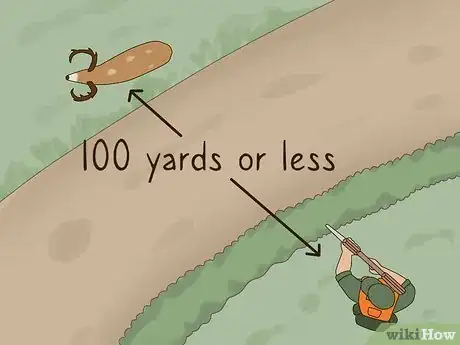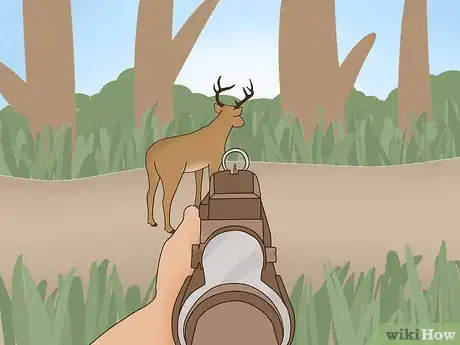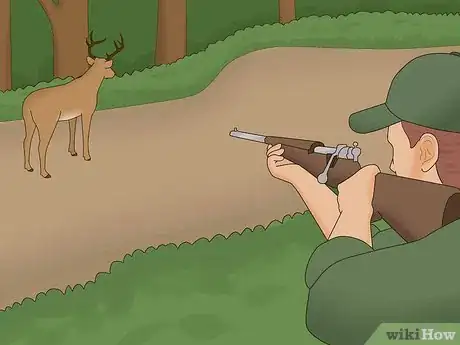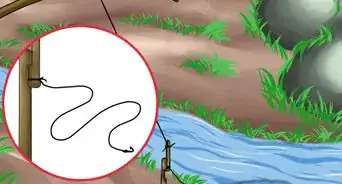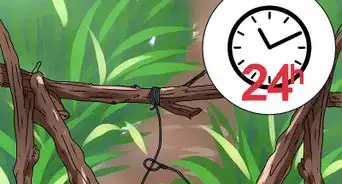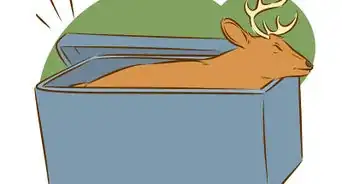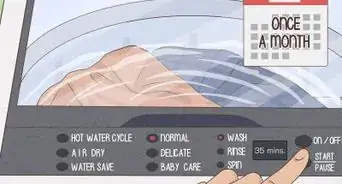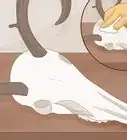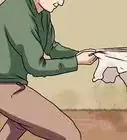This article was co-authored by wikiHow Staff. Our trained team of editors and researchers validate articles for accuracy and comprehensiveness. wikiHow's Content Management Team carefully monitors the work from our editorial staff to ensure that each article is backed by trusted research and meets our high quality standards.
There are 8 references cited in this article, which can be found at the bottom of the page.
This article has been viewed 99,945 times.
Learn more...
Whether you’re using a bow or a rifle, stalking a deer on foot can be a fun, adrenaline-filled way to bag a big buck and provide venison for your family. The key is to make yourself invisible to the deer and to have a whole lot of patience as you quietly walk through the area. But, with the right gear and strategy, you can stalk your prey and set up an open shot. To improve your chances of successfully stalking a deer on foot, go hunting during rutting season, which is when bucks are running around looking to mate. If there are other hunters in the area, or if it’s required by law, wear a bright orange hunting vest, which appears brown or gray to deer, but is easy for other people to see.
Steps
Bringing the Right Gear for Stalking
-
1Wear quiet, scent-free camouflage so deer can’t hear or smell you. Choose clothing colors that match the area you’ll be stalking in so you blend in. Put on pants, socks, and a shirt that are clean but don’t have a strong scent so deer won’t smell you. Camouflage will help keep deer from seeing you as easily, but so will dark clothing with earth tones such as brown and tan that match your surroundings.[1]
- Don’t wear blue or camouflage with a lot of white, which will be more visible to deer.
- Wear clothing that will keep your skin protected from branches or brush as you stalk.
- Avoid wearing velcro, which deer can hear coming from a distance.
- If it’s required, wear an orange vest. Deer are red-green colorblind, so they’ll see the orange as a brownish or gray color, but other hunters will be able to see you clearly.
-
2Avoid using scented soaps, deodorants, and detergent. Bathe without using soap or shampoo to rinse off any scents or sweat from your body before you go out stalking. Don’t use scented deodorant and don’t wash your clothes with a scented detergent so deer won’t smell you coming.[2]Advertisement
-
3Pack lightly to help you move quietly and avoid sweating. Choose a lightweight pack for supplies like water and ammunition. Keep your supplies to a bare minimum so you’re able to move silently while you stalk a deer, and so you don’t work up a sweat, which can drive deer away from you. Make sure your pack is tight-fitting so it doesn’t shift or move around as you stalk.[3]
- Deer have a highly sensitive sense of smell, and the scent of a human will spook them and prevent you from getting close enough to take a shot.
-
4Put on a hat to keep the sun out of your eyes. You’ll need to be able to see clearly in front of you, and a cap with a brim will help keep the glare out of your eyes as you stalk. Choose a hat that’s a color that matches your surroundings such as camouflage or an earth tone like grey or tan.[4]
- Avoid wearing a brightly colored cap so you’re not visible to deer.
-
5Choose light boots or shoes with soft soles to help you stalk quietly. Instead of traditional sturdy hunting boots, opt for lightweight boots or even shoes that will help you move lightly and quietly. Choose boots or shoes with soft soles that aren’t a bright color so they aren’t easily visible.[5]
- Dark sneakers can be a good option as well.
-
6Pack a pair of binoculars to help you spot deer. Wear a lightweight pair of binoculars around your neck to help you see further on your stalk. Extending your field of view will help you determine where you want to stalk as well as help you spot deer from a distance.[6]
- You could also use a range finder to help you determine how far a deer is or how far away a landmark is from your position.
Finding Deer to Stalk
-
1Choose an area where you’re likely to find deer to hunt. Look for legal hunting grounds in your area where deer have been spotted, such as woods, fields, and swampy areas. If you’re going hunting on private land or someone else’s property, ask them where deer are likely to be located so you can focus on stalking those areas.[7]
- Deer tend to bed in areas with thick brush and near food sources such as wild grasses, greenbriar, dandelions, and acorns.
- Some hunting lands may have areas that have been baited or where food has been placed to attract deer.
-
2Go stalking in the morning or in the evening. Wait until early morning just after the sun rises or dusk just as the sun is starting to go down to begin your stalk. Deer are naturally more active around dawn and dusk so you’ll have more of a chance of spotting them at those times.[8]
- Deer often bed down and stay in 1 location during the day, making it more difficult for you to come across any.
-
3Get to a high vantage point to look around before you stalk. Find a hill, cliff, or climb up a tall tree to scout the area before you begin your stalk. Look for any deer, signs of deer such as trails, or places where deer are likely to pass by like a stream or another source of water. Choose a direction to begin your stalk and get ready to hunt![9]
- Make a mental map or sketch out a rough drawing of the area so you can remember landmarks and areas you want to stalk.
-
4Take short, balanced steps and walk heel-to-toe to move silently. Keep your weight on your back foot and use your lead foot to feel the ground ahead for noisy sticks or leaves before you put your weight onto it. Move forward in short steps and step with your heel first, then gently flatten your foot to distribute your weight slowly and evenly. Keep your eyes and ears peeled for any signs of deer.[10]
- Pay attention to any rustling or movements. Deer can often suddenly emerge and you may have a small window to take a shot.
- Try to be as still and steady as you can while you stalk.
-
5Look for fresh deer tracks on the ground. Deer tracks look like 2 small, parallel hooves in mud, so keep an eye out for any as you stalk through the woods. In the grass, the tracks may look like a small circular pattern. Look for fresh tracks for signs that deer are in the area.[11]
- Sometimes, a deer’s hind feed can step on their front tracks, smearing them and making them hard to identify. Look for other tracks nearby to try to confirm that it’s a deer.
- If you find tracks, look to see how many deer there are. If there are multiple, there may be only female deer, also known as a doe, and young deer, called fawns. In many places, it’s illegal to shoot a doe or a fawn except for certain times of the year.
- A single set of deer tracks can indicate that a lone buck came through the area, so keep your eyes peeled!
-
6Keep the wind blowing in your face so you’re downwind. As you stalk, move in the direction where you feel the wind blowing over your face. The wind will carry your scent away from the direction you’re moving, making it difficult for deer to smell you coming.[12]
- Stalking with the wind at your back is a surefire way to scare off deer.
-
7Use your peripheral vision to watch for colors and movement. While you’re stalking, avoid moving your head back and forth to scan the surroundings because the movements could scare off nearby deer. Instead, keep your eyes fixed in front of you and use your peripheral vision to look for color changes and flashes of movement to help you identify potential prey.[13]
Closing in on a Deer
-
1Stand still and ready your weapon when you see or hear a deer. If you hear a sudden rustling or you spot a deer while you’re stalking, stop moving. Keep your eyes fixed on the deer and get ready to take your shot when the moment arises. Ready your rifle or prepare your bow so you’re set.[14]
- Avoid suddenly moving into your shot or you could blow the opportunity.
- Deer are curious animals, so if you spot one and it runs off, stay still. They may come back to investigate, and you’ll have another opportunity.
-
2Wait until the deer is within range and you have an open shot. If you’re bowhunting, you’ll want to wait until the deer is within 30–60 yards (27–55 m) to land an accurate shot. If you’re hunting with a rifle, wait until the deer is 100 yards (91 m) or less to increase your chances. Allow the deer to move into a position where you have a clear shot that isn’t obscured by rocks or trees.[15]
- Avoid trying to move to set up a better shot or you could spook the deer. Be patient and allow the deer to move into position.
-
3Anticipate the deer ducking or turning to run as you shoot. When you draw your bow or raise your rifle to take a shot, it’s possible the deer will sense the motion and may react. Be ready to make adjustments if the deer ducks down suddenly or begins to turn to run away so you can still land your shot.[16]
- Stalking a deer in general means you’re closer and making more noise than other forms of hunting, so the deer may already be on high alert.
-
4Take your shot as soon as it’s available to you. Once you have a clear opening and the deer is in range, don’t hesitate. Draw your bow or raise your rife, aim for the deer’s chest region for a better chance of landing a kill shot, and fire. If the deer is hit but doesn’t immediately go down, follow after it until it eventually collapses, and approach it carefully. Make sure the deer isn’t breathing before you attempt to move it.[17]
- A wounded deer, especially a strong buck, can injure you if you get too close. Wait until the deer has collapsed and isn’t breathing.
- Although stalking involves a lot of patience and slow movement, when the time is right, move quickly and take your shot.
Community Q&A
-
QuestionHow do I make a deer come to me so I can touch it?
 Community AnswerYou should not ever touch a deer, as they carry disease - but the best way would be to use food scents and calls.
Community AnswerYou should not ever touch a deer, as they carry disease - but the best way would be to use food scents and calls.
Warnings
- Don’t shoot a doe or a fawn if it isn’t legal in the area you’re hunting. You could face a fine or lose your hunting privileges.⧼thumbs_response⧽
- Be very cautious approaching a wounded deer. They can suddenly jump up and their antlers can cause serious injury. Wait until the deer has stopped breathing before you get close enough to touch it.⧼thumbs_response⧽
- If there are other hunters in the area, or if it’s required by law, wear an orange vest so you’re visible to humans but not to deer.⧼thumbs_response⧽
References
- ↑ https://outdoorempire.com/deer-stalking/
- ↑ https://www.grandviewoutdoors.com/big-game-hunting/complete-guide-spot-stalk-hunting
- ↑ https://www.grandviewoutdoors.com/big-game-hunting/complete-guide-spot-stalk-hunting
- ↑ https://www.grandviewoutdoors.com/big-game-hunting/complete-guide-spot-stalk-hunting
- ↑ https://outdoorempire.com/deer-stalking/
- ↑ https://www.grandviewoutdoors.com/big-game-hunting/whitetail-deer/ground-stalking-whitetail-deer
- ↑ https://www.deeranddeerhunting.com/content/blogs/dan-schmidt-deer-blog-whitetail-wisdom/how-to-deer-hunt-on-public-land
- ↑ https://www.outdoorlife.com/ground-pounders-expert-advice-on-how-to-come-down-from-trees-and-hunt-on-your-own-two-feet/
- ↑ https://www.americanhunter.org/articles/2018/8/15/tips-and-tactics-for-bowhunting-mule-deer/
- ↑ https://www.fieldandstream.com/articles/hunting/2013/11/how-still-hunt-and-stalk-deer/
- ↑ https://www.grandviewoutdoors.com/big-game-hunting/complete-guide-spot-stalk-hunting
- ↑ https://www.shootinguk.co.uk/shooting/deer-stalking
- ↑ https://www.grandviewoutdoors.com/big-game-hunting/complete-guide-spot-stalk-hunting
- ↑ https://www.outdoorlife.com/ground-pounders-expert-advice-on-how-to-come-down-from-trees-and-hunt-on-your-own-two-feet/
- ↑ https://www.americanhunter.org/articles/2018/8/15/tips-and-tactics-for-bowhunting-mule-deer/
- ↑ https://www.grandviewoutdoors.com/big-game-hunting/whitetail-deer/ground-stalking-whitetail-deer
- ↑ https://www.outdoorlife.com/ground-pounders-expert-advice-on-how-to-come-down-from-trees-and-hunt-on-your-own-two-feet/
